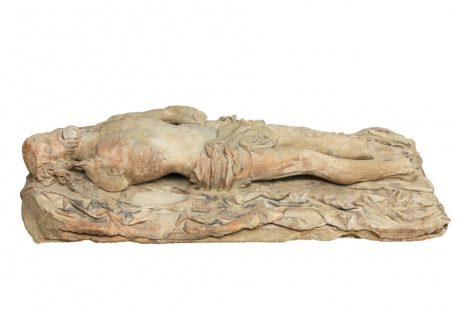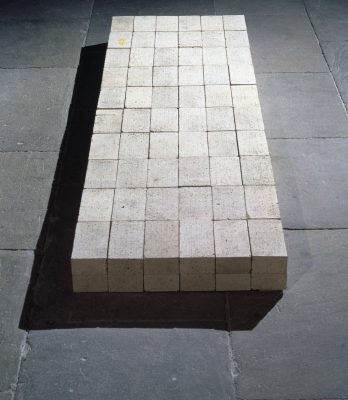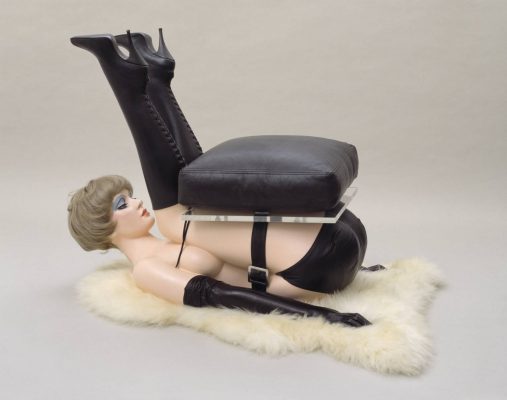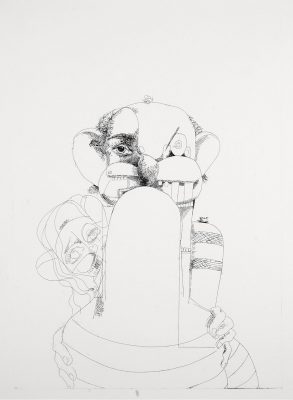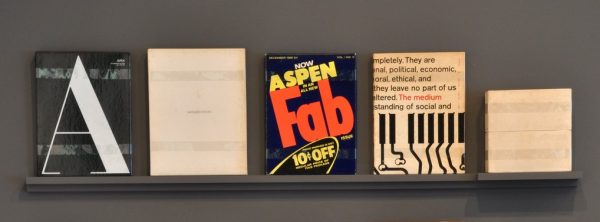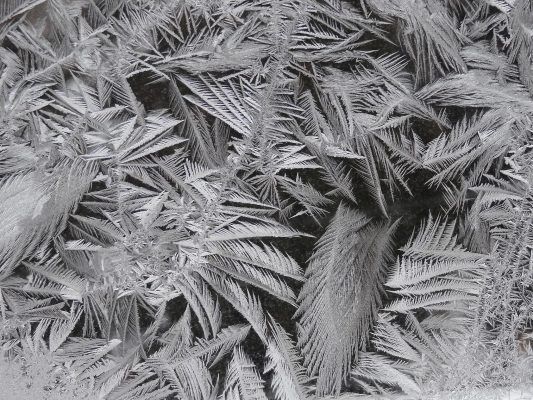Iconoclasts have never known quite what to do with the ruined fragments that they leave behind. If we imagine the first English iconoclasts in action as they undertook to rid churches of images and holy objects in the sixteenth century, images of grim-faced fanatics wielding hammers and flaming torches are likely to spring to mind. But if iconoclasm is loud and violent in its fury, it is haunted by its quiet aftermath, in which the meanings that it releases prove troublingly difficult to control. One response might be to leave nothing behind at all. In 1547, as iconoclasm in England assumed new ferocity under Edward VI, a royal injunction urged the clergy to remove and destroy all ‘monuments of feigned miracles, pilgrimages, idolatry and superstition; so that there remain no memory of the same’.
This enforced forgetting, however, was a dangerous strategy. If superstition were utterly purged and its memory obliterated, there was the risk that it might be repeated. The overcoming of error needed to be remembered if its repetition were to be guarded against. In many churches broken statues or desecrated images were accordingly left in situ, as salutary reminders of a reviled past. This too had its risks, however. Even in their broken form, such idols might continue to inspire reverence rather than revulsion. After all, if the fragmentation of relics in the Middle Ages in no way reduced their sanctity – a splinter from the True Cross was as holy as the whole – then the sacred remained sacred even in its ruined state. Iconoclasm, which seemed to aim at absolute and irrevocable change, turned out to be torn between forms of remembrance and forgetting that it could not fully control.
Art Under Attack is the first exhibition devoted to the history of British Iconoclasm, and it is in many ways the realisation of an iconoclast’s nightmares. If the iconoclast wants the object to vanish and be forgotten, the exhibition reveals the stubborn tendency of defaced objects to linger and accrue new meanings. The first two rooms, devoted to the Reformation of the sixteenth and seventeenth century, testify both to the devastating success with which English churches and monasteries were shorn of their treasures, and the recalcitrant refusal of holy things to vanish altogether. The survival of some of these objects suggests another risk of total obliteration. If an object lingered in its ruined state, one at least knew where it was and could seek to control its meaning. If it vanished and had supposedly been consigned to oblivion, such an object might instead have been squirreled away for the purpose of continued and secret devotion, like the many holy things that emerged unscathed, having been secreted in dunghills or beneath floorboards, when Mary I ascended to the throne and reinstated traditional forms of worship.
The first room of this exhibition is its most remarkable, not least for the range of surviving objects that it brings together, some of which remained in their hiding places until the twentieth century. There is a particularly spectacular contrast between two images of Christ which survived total destruction to eventually re-emerge, nearly contemporaneously, in the twentieth century. The first, a statue of the Dead Christ, was unearthed in 1954 in the Mercer’s Chapel in the City of London during reconstruction following the Blitz. It is a magnificently naturalistic and life-size piece, impressive in scale but also punctuated with minute detail, including a drop of blood that have been sculpted between two words of the Latin inscription as if it had dropped freshly from the recumbent body. The second image, more rudimentary, is a wooden figure several inches high, the remnant of a crucifix, which was found in 1952 in Fiddleford Manor in Dorset. Questions crowd around this contrasting pair. Both are broken, the statue lacking its hands, feet, and four of its five wounds, while the small wooden figure is armless. Were they broken and then allowed to linger so that the humiliation of idols could be continuously celebrated? Or were they rescued following these initial acts of ruination, carefully hidden, and revered even in their broken state?
These first rooms are the exhibition’s strongest, or perhaps it is that they provoke the least equivocal response because we are separated by several centuries from the acts of violence to which they testify. We might lament the loss of so much beauty, but we are likely to do so with wistfulness rather than raw outrage. Occasionally, a defaced object assumes a strange new beauty that its desecrators could not possibly have anticipated. A rood screen from Norfolk that showed Christ as the Man of Sorrows was effaced with whitewash and covered with English Bible verses in the sixteenth century, but the whitewash has faded over time, leaving the once-concealed Christ peering out through the bars of the black letters. We are prevented from enjoying the splendour of the original, but a new pleasure emerges from appreciating the artefact in its altered state. The screen is a palimpsest, as a microcosm of iconoclasm itself in that is simultaneously ruins the original image and fails to abolish it altogether.
As it moves from the seventeenth into the eighteenth century, the exhibition becomes more polemical and contentious. Its scope begins to expand from the specific phenomenon of iconoclasm in the Reformation to the destruction of art in all of its forms, and it asks us to see these as part of a single and continuous tradition. The exhibition is structured around a trifold division: progressing through its rooms one moves from the religious, to the political, to the aesthetic, with the progression somewhat gratingly emphasised by the changing colour of the walls. This is one of its less satisfying characteristics, since we are asked both to separate these realms too neatly (as if neither religious iconoclasm nor even the most abstract art were political) and too conflate them too swiftly as varieties of a single phenomenon. The exhibition could have probed the stakes of this progression, but it does not. The imperial equestrian statues destroyed in Dublin and New York are probably the least scintillating of the exhibits, emphasising iconoclasm as a way of contesting the ownership of public space.
Things become more interesting and provocative when we enter the room devoted to artworks violently targeted by the suffragettes. This occurred most famously in the case of Velázquez’s so-called ‘Rokeby Venus’(not on display here) which was attacked in the National Gallery. Here we are shown John Singer Sargent’s portrait of Henry James that was slashed with a meat cleaver in 1914. It was apparently targeted without knowledge of the sitter’s identity, but the assault still left the novelist feeling ‘very scalped and disfigured’. The viewer is presumably intended to feel an uncomfortable tension between sympathy for these particular vandals’ cause and outrage at the vandalism itself. If we accept that acts of civil disobedience designed to provoke outrage contributed in some holistic sense to the eventual attainment of universal suffrage, then is the damaging of a few paintings a price worth paying? This room also poses implicit questions regarding the value of reconstruction and repair. Once an artwork has been marked or slashed, should every effort be made to restore its original pristine state? Or is the act of violent marking then an inescapable part of that artwork’s history, a history which should not be entirely erased? This is clearly a dangerous argument to advance, and one which would allow any fool or blackguard to claim a place in the history of a great work by besmirching it. Like most viewers of the exhibition, I imagine, I found myself agreeing with the sentiment of Wyndham Lewis from BLAST magazine in 1914, which is on display here, and which implored suffragettes to ‘Only leave works of art alone. You might some day destroy a good picture by accident!’ But this room seemed to provoke questions worth asking, and genuinely integral to the nature of iconoclasm. Is it not disingenuous both to benefit from specific historical transformations, and to deplore the violent and destructive means by which they came about?
The oddly creative outcomes of destruction come to the fore in the next room through an account of the ‘Destruction in Art’ symposium of 1966, and Gustav Metzger’s creation of self-destroying artworks. Particularly noteworthy are the attempts by Raphael Montañez Ortiz to create new works through the devastation of everyday objects. His ‘Duncan Chair Terrace Destruction’ is one of the exhibition’s highlights (much more impressive, to my mind, than the more famous ‘Duncan Chair Piano Destruction’, which is also on display). The chair is mounted on the wall having been ripped, pummelled and flattened. It is horrifying but gripping, hovering between the obviously synthetic and a sense of the painfully animate. From different angles it resembles mummified viscera, bubbling toxic waste, or some sort of giant alien fungus. Arguably, though it is an emphatic record of an act of violent ruination, this work prompts less ambivalence than others on display because we are less likely to lament the loss of an everyday chair than the destruction or irreversible alteration of a unique painting or sculpture. By mounting these decimated objects on a wall and asking them to perform in the manner of artworks, Ortiz seems also to ask whether any act of aesthetic creation involves destruction: as if to apply brush or a chisel were to ruin the unspoilt integrity of a canvas or a block of stone no less than when he took his axe to a piano.
This same possibility is addressed in a different way by the least likeable works on display, from Jake and Dinos Chapman’s series ‘One Day You Will No Longer Be Loved’, in which portraits in oil are emended and ‘improved,’ the sitters’ faces made to sink and decay. These works are admittedly more interesting than the Chapman brothers’ usual brand of shrill, witless nihilism (I would exclude from this general description their pleasingly blockish metal dinosaur sculptures). They set about demeaning not just any portrait but works that, they claim, had been abandoned by being sold off, and therefore separated from the affections and intimate attachments that caused them to be painted in the first place. The unloved portrait, discarded by the family and made into a commodity, is, on this account, a sort of found object, ready to be reshaped and redeployed. Where Ortiz destroyed everyday objects, the Chapmans alter average works of art, as if the loss of a minor portrait is less lamentable than that of a rather fine chair.
Finally, however, I found myself unwilling to accept this sympathetic appraisal of the Chapmans’ work, not least because of the way that it was situated as the culmination of the exhibition. The decision to place the Chapmans as the terminus ad quo of British iconoclasm is symptomatic of this exhibitions oddly pallid acceptance of acts of creative destruction, its implicit insistence that all such acts are equally interesting or worthy. In the final rooms, the Chapmans’ works and those of Ortiz are juxtaposed with modern artworks that have been broken, not by the artist, but by visitors to galleries. These attacks were prompted by various motives: anger at the perceived misogyny of the work (in the case of the paint thinner poured onto the face of the folded female figure in Allen Jones’s ‘Chair’); a furious sense that the work insulted the very people that it claimed to commemorate (Laszslo Szilvassy, a Hungarian refugee, crushed Reg Butler’s maquette for ‘The Unknown Political Prisoner’, convinced that its meagre wires demeaned rather than celebrated the sufferings of actual prisoners); or the rejection of the work qua artwork, a refusal to accept its aesthetic and financial worth. When Carl Andre’s ‘Equivalent VIII’, an orderly row of bricks, was splashed with blue food dye in 1976, it was part of a wider outrage that public money had been spent on such a work in a way that made its value commensurate with that of a Monet or a Titian. As Stanley Cavell has observed, modern art changes the nature of aesthetic debate not least through the terms in which works are criticised. Rather than saying it is simply poor a work’s detractors seek to deny that it is art at all: ‘this is bad art’ is replaced by ‘this is not art.’ The assault or destruction of the work is the realisation of this objection. It becomes another way of insisting that such a work is a mere worthless object, to be destroyed like any other.
This exhibition is certainly worth visiting, especially for the treasures with which it begins. One is left, however, with a queasy sense of the risks of intellectualising destruction without sufficient discrimination. The exhibition wants to insist that the breaking of art in Britain is part of a continuous tradition. The sixteenth century iconoclasts who broke the limbs from the dead Christ, the Chapman brothers ‘improving’ a portrait, and the man who splashes dye on Carl Andre’s bricks are, it is implied, undertaking versions of the same action. But, of course, in this exhibition the conventional gallery sign hangs next to ‘Equivalent VIII’ reminding viewers not to touch. It is interesting that a work has previously been attacked, but we are politely reminded that such behaviour is not encouraged here. The earlier attacks on these works, even if they took place as recently as the 1970s, are already consigned safely to history, as distant from us in their intensity as the fervour of the 1540s.
There is something frustratingly tepid about this flattening out of all acts of destruction. It suggests, falsely, that we have entered an era in which artworks cannot and should not provoke the sort of intense response that leads people to deface them. Incidentally, the exhibition also overlooks the range of reasons for which such acts occur. Marks are often left on artworks for reasons of love rather than loathing, from the ancient story of the young man who fell in love with a statue and left the traces of his affection for aftertimes to witness, to twentieth century instances of portraits kissed in galleries. I am not suggesting that such behaviour be encouraged, but it is worth remembering that the history of iconoclasm is not only the history of violence. This exhibition does a good job of raising some of the complex questions that cluster around the history of attacks on art, but it would still have been able to do so while giving voice to some of the outrage that it will inspire in most of its viewers. Violence against art can be both terribly interesting, and simply terrible.
I was reminded as I made my way through these rooms of a small exhibition that I saw some years ago in a library, which showcased the various sorts of damage suffered by books from its collection. This ranged from marginalia in biro to works largely destroyed by fire, and one remarkable instance of a book with the tracks of a car tyre left diagonally across its open pages. The exhibition raised some of the questions provoked by Art Under Attack: why is marginal scribbling from the sixteenth century fascinating, while if it happened last week it is an irritation? How long does it take for an act of destruction to stop provoking outrage, and to become a phenomenon worthy of historical interest? What I remember most clearly about this exhibition, though, is the wonderfully dry tone with which it had been curated. The librarians clearly took a certain impish pleasure in skewering particularly clottish marginal notes, and speculating as to the bizarre circumstances that led to a book being run over (careless reading at a traffic light, perhaps). There was no doubt that such mishaps were to be lamented, and deliberate defacement to be discouraged. The exhibition was temporary, before the books in question began to undergo conservation and repair. It managed to make destruction interesting without validating it, or forgetting that it is still, despite the paradoxically creative implications with which the first English iconoclasts struggled, easier than creation.
